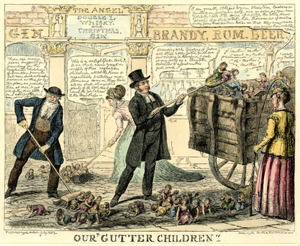KINDRED LINES: ‘HOME CHILDREN’—AN IRISH PERSPECTIVE, 1860s TO 1922
Published in Features, Issue 3 (May/June 2023), Volume 31By Fiona Fitzsimons

Above: Our ‘Gutter Children’ by George Cruikshank (1869), a reference to Maria Rye’s campaign for the emigration of children to Canada, proposed in a letter to The Times, 29 March 1869. (British Museum)
Between the 1860s and the 1930s, over 100,000 child and juvenile emigrants were sent from the UK to Canada, Australia and New Zealand as part of the ‘Home Child Scheme’. Most Home Children were aged from seven to fourteen, although we find much younger children from two years upwards as well as young people (15–23) in the scheme.
All of the children and young people came from deprived backgrounds, and many were already in care. The churches, charitable organisations and Poor Law unions that were their caregivers selected children, many of whom were too young to give their rational consent, often without the knowledge or consent of their parents or guardians.
Once processed, the child emigrants were sent to ‘receiving’/‘distribution’ homes, often named after the charitable organisations that ‘brokered’ migration: in Canada, the Quarriers and Fairbridge Farms; in Australia, Barnardo’s Burwood and the Christian Brothers’ Boys’ Towns at Clontarf, among others. (Australia appears to have boarded the children in Farm Schools, Orphanages and Boys’ Towns.)
In Canada, farmers could apply to the homes for a child; their applications were supported by a recommendation from a clergyman or other pillar of the community. The homes allowed prospective ‘fosterers’ to make a visual inspection of all children to choose from.
The scheme drew on new ideas of child development and of empire. If the children of the urban poor were removed from the cities, and implicitly from their families, they could be sent overseas to a ‘better life’ in the dominions and be educated as the future settlers, workers and soldiers that the ever-expanding empire needed. Host families undertook to educate the children, and to ensure their moral formation through attendance at religious services and Sunday schools. The reality was that the children were used as cheap labour; they received very little training or education. Many Home Children were neglected and abused—in the worst-case scenarios, children died or, worse, took their own lives.
The evidence we have for Irish-born Home Children is limited by our access to the records. We don’t have access to the Australian records, although on 21 March 2023 the Scottish Child Abuse Inquiry released the first volume of findings relating to the migration of Scottish children to Australia. This will take time to digest. In the meantime, almost everything we know is taken from the Canadian records: passenger lists (1869–1948) and Department of Immigration Juvenile Inspection cards (c. 1913–32). These have been indexed without any knowledge of Irish place-names. Where child emigrants were recruited outside an institutional setting, the index doesn’t always record from where. In 1899 the enigmatic ‘Mr Delvin, Ireland’, brokered emigration for a group of young women with a median age of nineteen. There are almost certainly other Irish in the records, currently obscured by an imperfect index. Even with these caveats, we find over 1,000 Irish Home Children mainly sent out from workhouses, including in 1880 Ballyshannon, Co. Donegal (29), in 1881 Carrick Shannon [sic] (19), and in 1880–1 Dublin South Union (46) and Old Castle, Co. Meath (31), as well as from privately run institutions, including the Meath Industrial School, Blackrock, Co. Dublin, and St Kevin’s Reformatory School, Glencree, Co. Wicklow.
Many questions remain about the actual numbers of Irish Home Children, how they were recruited in Ireland and whether all such schemes ended after 1922.
Fiona Fitzsimons is a director of Eneclann, a Trinity campus company, and of findmypast Ireland.
















